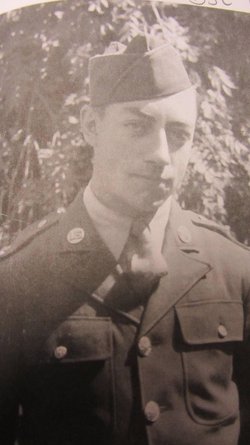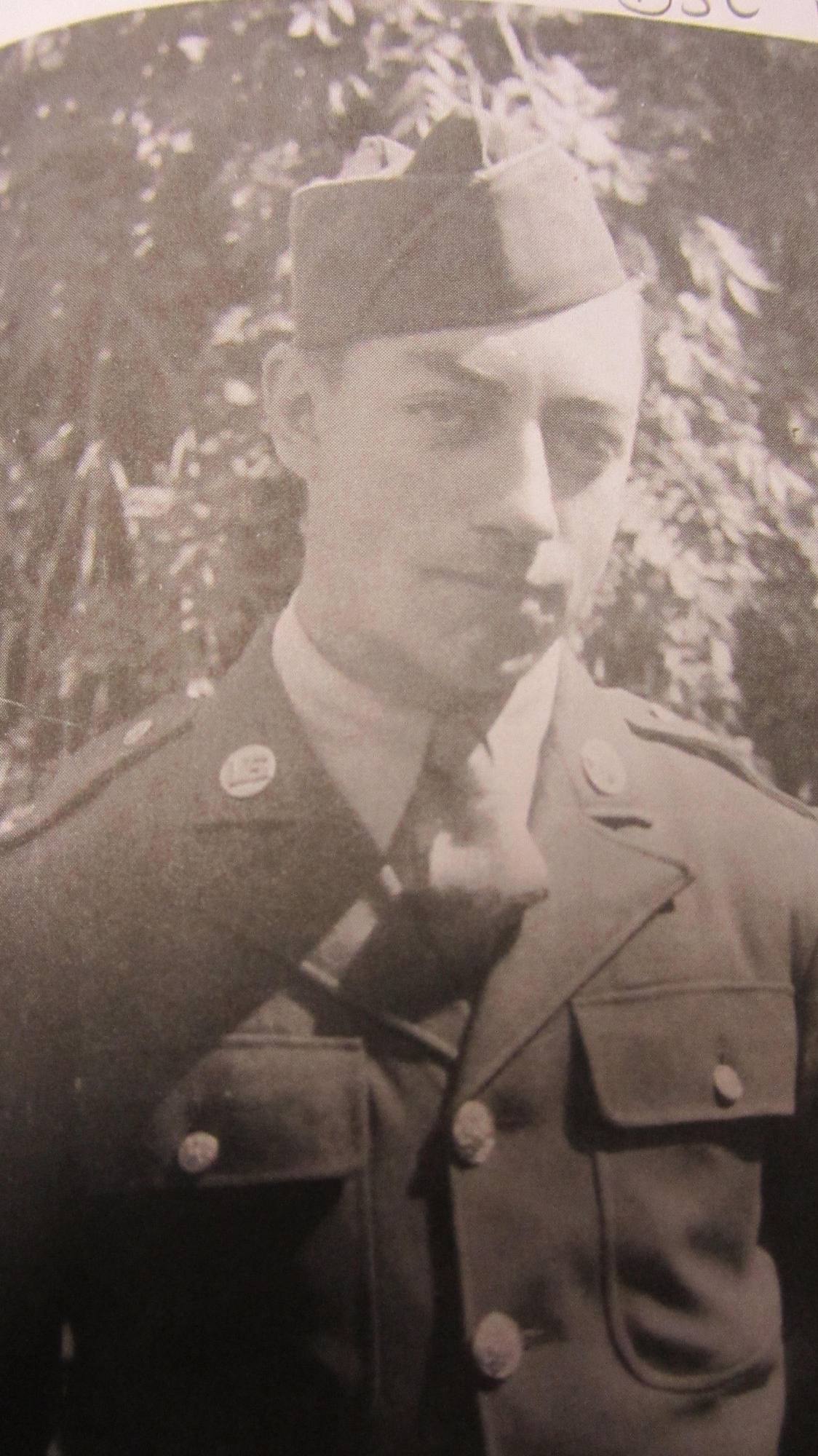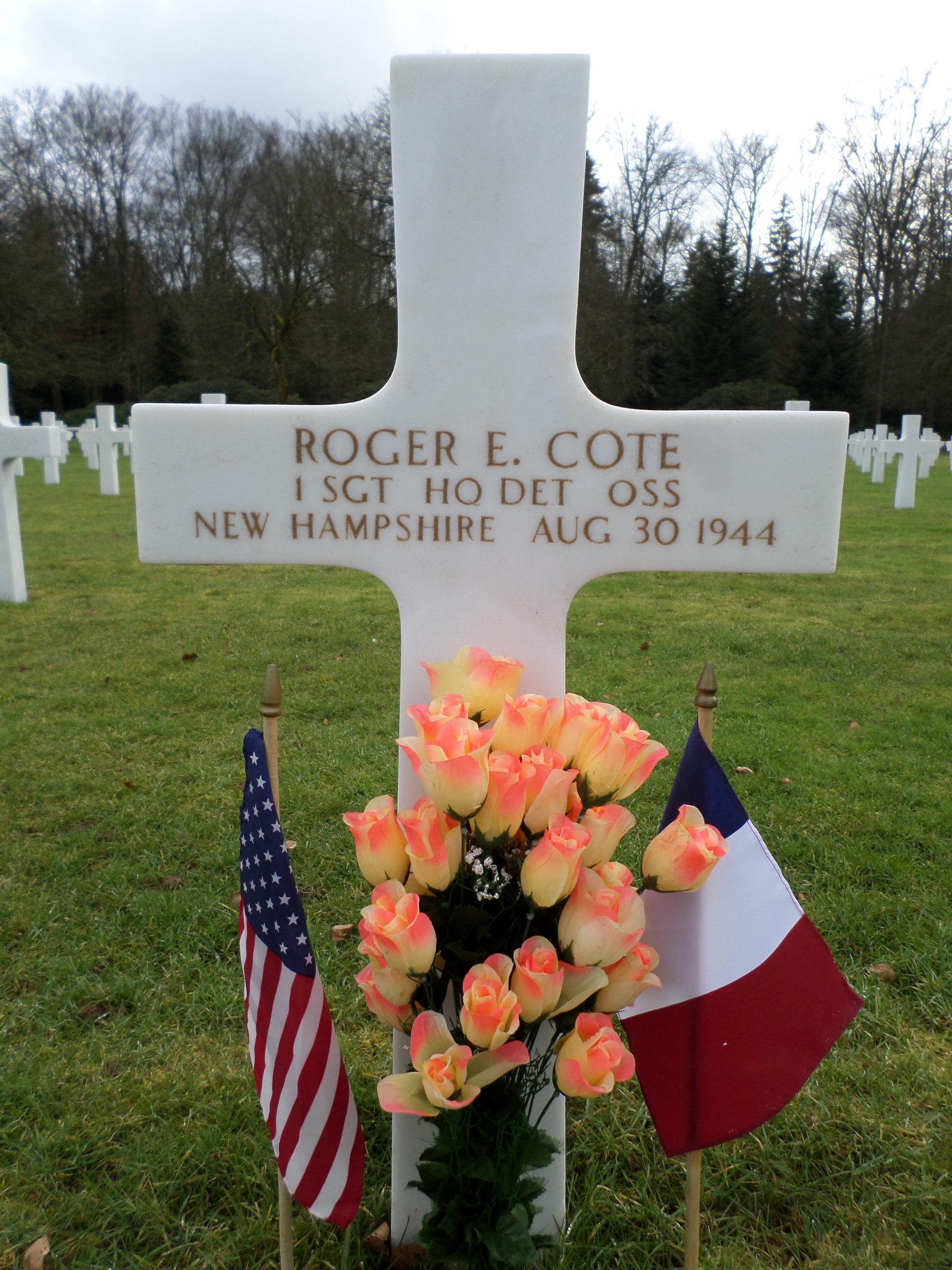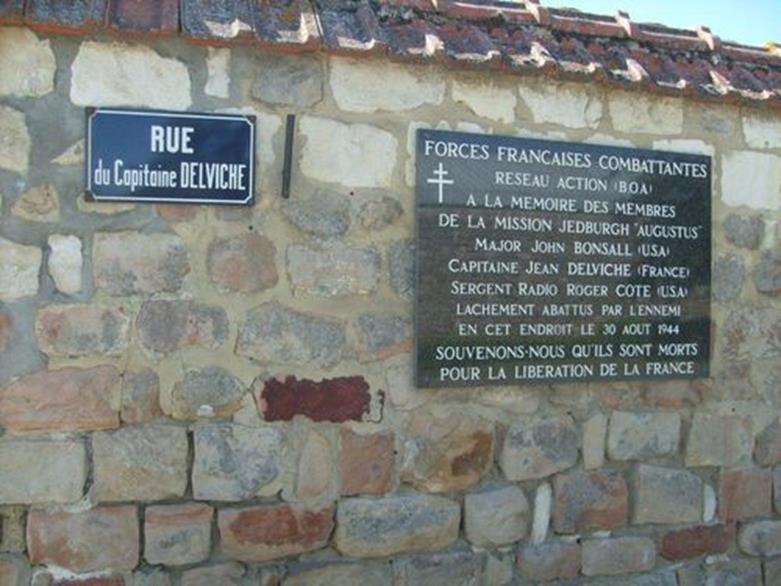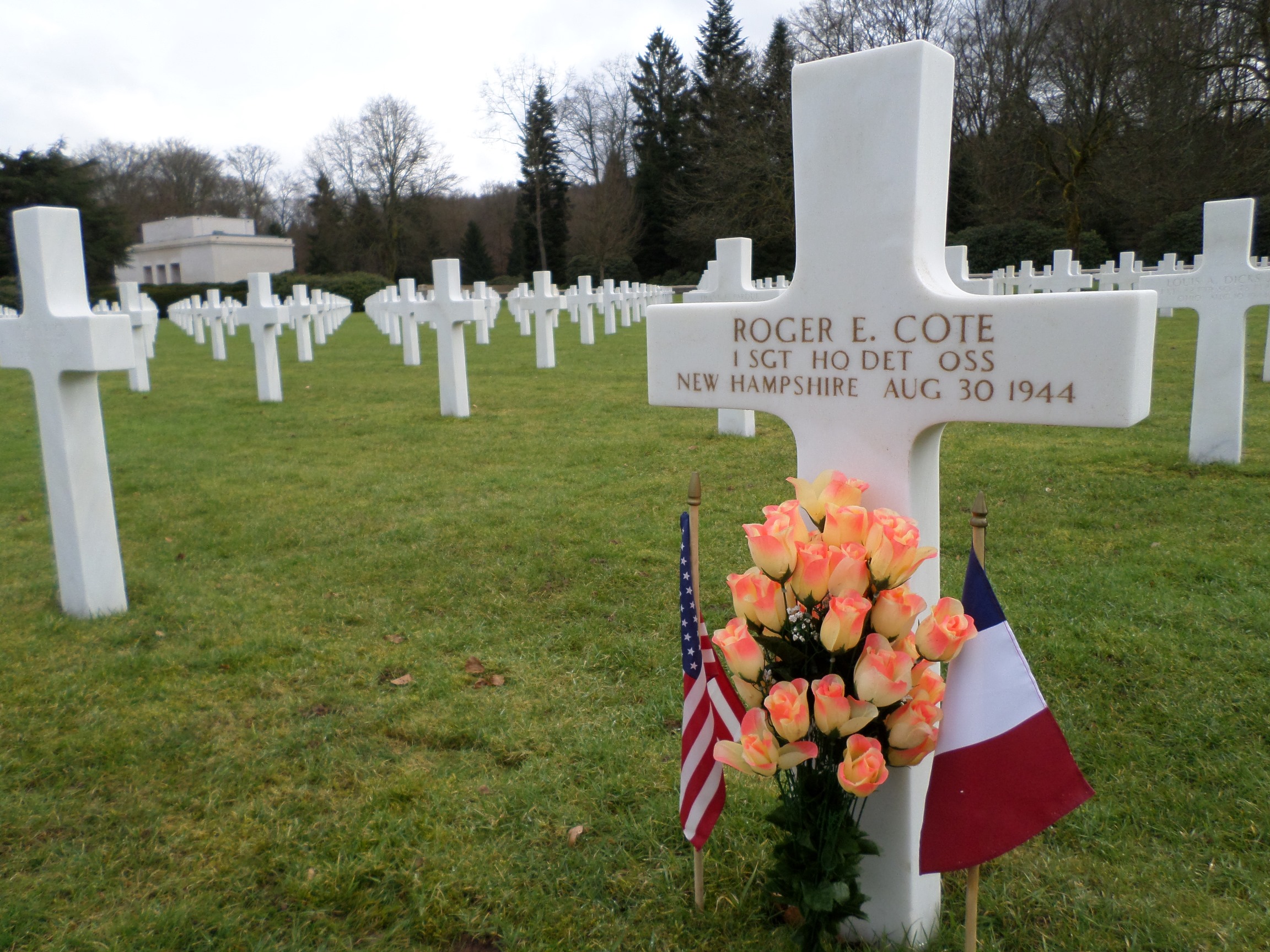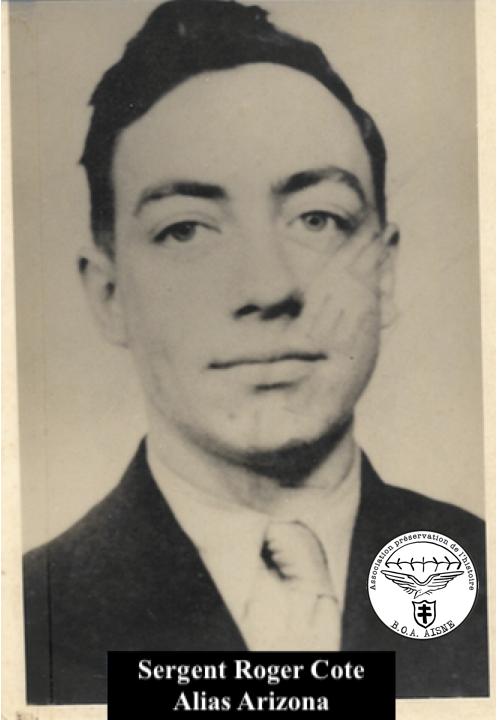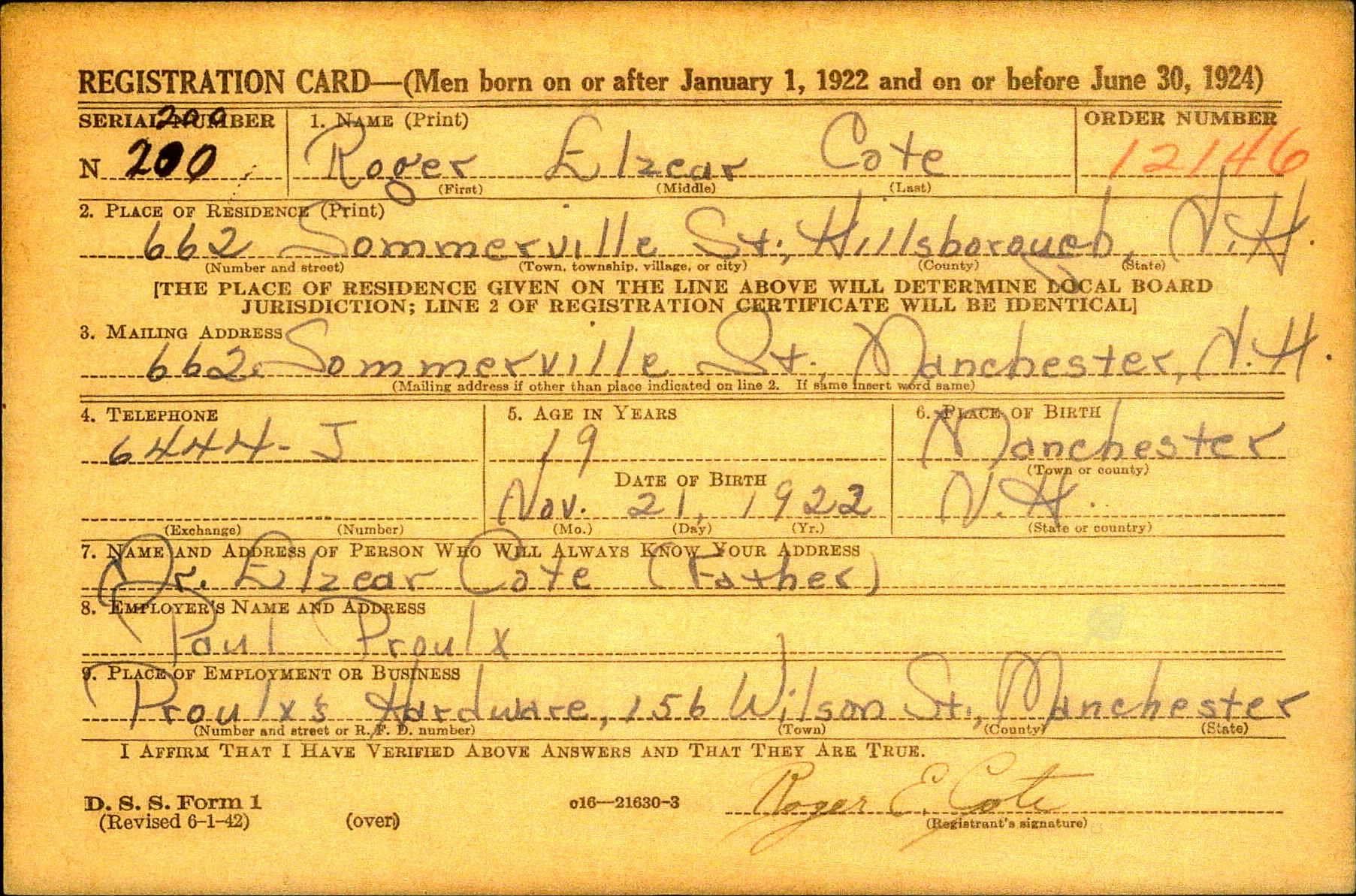The Jedburgh Team was a special forces operation carried out by the Allies during WWII, which aimed to coordinate the action of the French Resistance with the general plans of the Supreme Headquarters Allied Expeditionary Forces (SHAEF) and to provide weapons and training to the Resistance.
He resided in Hillsborough County, New Hampshire prior to the war.
He enlisted in the Army on November 9, 1942 in Manchester, New Hampshire. He was noted as being employed as a Office Clerk and also as Single, without dependents.
Roger was one of three soldiers "Executed" by the German Army in France during the war. (see below story)
He was awarded the "Distinguished Service Cross" and the Purple Heart.
Service # 11084219
Son of Elzear L. Cote who resided in Newton, Massachusetts.
The three executed:
Bonsall, John Halsey ~ Major, NJ
Cote, Roger E ~ 1st Sgt, NH
Delviche, Jean ~ Captain, French Army
Bio by:
Russell S. "Russ" Pickett
~ ~ ~ ~ ~ ~
Below Citation Synopsis submitted by:
Dwight "Andy" Anderson.
Distinguished Service Cross:
First Sergeant Roger E. Cote (ASN: 11084219), United States Army, was awarded the Distinguished Service Cross (Posthumously) for extraordinary heroism in connection with military operations against an armed enemy while serving with Headquarters, Office of Strategic Services, in action against enemy forces from 15 through 30 August 1944, in France. First Sergeant Cote's intrepid actions, personal bravery and zealous devotion to duty at the cost of his life, exemplify the highest traditions of the military forces of the United States and reflect great credit upon himself, his unit, and the United States Army.
General Orders: Headquarters, European Theater of Operations, U.S. Army, General Orders No. 61 (1945)
Action Date: August 15 - 30, 1944
Service: Army
Rank: First Sergeant
Company: Headquarters
Division: Office of Strategic Services
~ ~ ~ ~ ~ ~
Below story submitted by:
Dwight "Andy" Anderson.
All three members of Jedburgh Team "Augustus" were captured and executed in August 1944.
The commander of Team Augustus was Major John H. Bonsall, a Princeton University graduate from Morristown, New Jersey. He had become an artillery officer in 1941 and an OSS Special Operations officer in 1943, undergoing training at Areas F and B that year before being sent to England to become a Jed.
In Britain, the 25-year-old Bonsall was teamed up with Sergeant Roger Côté, 21, a radio operator from Manchester, New Hampshire who had graduated from Area C, and Captain Jean Delviche of the French Army.
On 15 August, they were dropped about one hundred miles northeast of Paris, near Soissons in Picardy, behind the lines of the rapidly retreating German Army. A few members of the Resistance greeted them, but Bonsall soon radioed London that it was "impossible to form maquis now due to ONE: too many Boche [Germans]; TWO, lack of good hiding areas; and THREE, very few arms."
Indeed, movement by these three Jeds was extremely risky because the entire area was still contested, with German units in rapid retreat, pursued by advance elements of Patton's Third Armored Division less then six miles away.
The fast-moving American armored forces had already overrun the area originally assigned to Bonsall's team, and the Jeds found themselves behind American lines.
Instead of considering their mission over, however, Team Augustus decided to re-cross the fluid lines, get back behind the fleeing German forces and organize the maquis there to attack German convoys.
On the stormy, rainy night of 30 August 1944, dressed as French civilians and with false identification papers, the three Jeds borrowed a horse-drawn peasant cart from a friendly farmer and with their weapons and radio under a load of hay, they started off on the back roads.
They had traveled more than a dozen miles when, late that night, as they arrived at the village of Barenton-sure-Serre, three miles from their destination, the storm had grown so fierce and the night so dark, that the Jeds probably did not see the three German tanks posted at a check point at the rural intersection until they were at them.
Around 11 p.m., some residents of the nearby village heard a dozen shots. Half an hour later, the tanks, elements of either the 9th S.S. Panzer Division or the 116th Panzer Division moved out, continuing the German retreat eastward.
In the morning, the villagers found three bodies at the intersection, all with bullet holes in the back of the head. Bonsall and Deviche lay side by side; Côté, who had apparently made a break for it, lay face down, his arms outspread, a dozen yards away. The Germans had stopped the wagon, probably found the weapons and radio in the back, concluded the men were spies and decided to execute them summarily.
In the morning, the villagers buried the three in unmarked graves beside the local church and put a French flag over them; the maquis arrived and held a military ceremony.
Later that day, the U.S. 3rd Armored Division swept through the area on the heels of the retreating German forces.
~~~~~~~~~~~~~~~~~~~~~~~~~~~~~~~
The Jedburgh Team was a special forces operation carried out by the Allies during WWII, which aimed to coordinate the action of the French Resistance with the general plans of the Supreme Headquarters Allied Expeditionary Forces (SHAEF) and to provide weapons and training to the Resistance.
He resided in Hillsborough County, New Hampshire prior to the war.
He enlisted in the Army on November 9, 1942 in Manchester, New Hampshire. He was noted as being employed as a Office Clerk and also as Single, without dependents.
Roger was one of three soldiers "Executed" by the German Army in France during the war. (see below story)
He was awarded the "Distinguished Service Cross" and the Purple Heart.
Service # 11084219
Son of Elzear L. Cote who resided in Newton, Massachusetts.
The three executed:
Bonsall, John Halsey ~ Major, NJ
Cote, Roger E ~ 1st Sgt, NH
Delviche, Jean ~ Captain, French Army
Bio by:
Russell S. "Russ" Pickett
~ ~ ~ ~ ~ ~
Below Citation Synopsis submitted by:
Dwight "Andy" Anderson.
Distinguished Service Cross:
First Sergeant Roger E. Cote (ASN: 11084219), United States Army, was awarded the Distinguished Service Cross (Posthumously) for extraordinary heroism in connection with military operations against an armed enemy while serving with Headquarters, Office of Strategic Services, in action against enemy forces from 15 through 30 August 1944, in France. First Sergeant Cote's intrepid actions, personal bravery and zealous devotion to duty at the cost of his life, exemplify the highest traditions of the military forces of the United States and reflect great credit upon himself, his unit, and the United States Army.
General Orders: Headquarters, European Theater of Operations, U.S. Army, General Orders No. 61 (1945)
Action Date: August 15 - 30, 1944
Service: Army
Rank: First Sergeant
Company: Headquarters
Division: Office of Strategic Services
~ ~ ~ ~ ~ ~
Below story submitted by:
Dwight "Andy" Anderson.
All three members of Jedburgh Team "Augustus" were captured and executed in August 1944.
The commander of Team Augustus was Major John H. Bonsall, a Princeton University graduate from Morristown, New Jersey. He had become an artillery officer in 1941 and an OSS Special Operations officer in 1943, undergoing training at Areas F and B that year before being sent to England to become a Jed.
In Britain, the 25-year-old Bonsall was teamed up with Sergeant Roger Côté, 21, a radio operator from Manchester, New Hampshire who had graduated from Area C, and Captain Jean Delviche of the French Army.
On 15 August, they were dropped about one hundred miles northeast of Paris, near Soissons in Picardy, behind the lines of the rapidly retreating German Army. A few members of the Resistance greeted them, but Bonsall soon radioed London that it was "impossible to form maquis now due to ONE: too many Boche [Germans]; TWO, lack of good hiding areas; and THREE, very few arms."
Indeed, movement by these three Jeds was extremely risky because the entire area was still contested, with German units in rapid retreat, pursued by advance elements of Patton's Third Armored Division less then six miles away.
The fast-moving American armored forces had already overrun the area originally assigned to Bonsall's team, and the Jeds found themselves behind American lines.
Instead of considering their mission over, however, Team Augustus decided to re-cross the fluid lines, get back behind the fleeing German forces and organize the maquis there to attack German convoys.
On the stormy, rainy night of 30 August 1944, dressed as French civilians and with false identification papers, the three Jeds borrowed a horse-drawn peasant cart from a friendly farmer and with their weapons and radio under a load of hay, they started off on the back roads.
They had traveled more than a dozen miles when, late that night, as they arrived at the village of Barenton-sure-Serre, three miles from their destination, the storm had grown so fierce and the night so dark, that the Jeds probably did not see the three German tanks posted at a check point at the rural intersection until they were at them.
Around 11 p.m., some residents of the nearby village heard a dozen shots. Half an hour later, the tanks, elements of either the 9th S.S. Panzer Division or the 116th Panzer Division moved out, continuing the German retreat eastward.
In the morning, the villagers found three bodies at the intersection, all with bullet holes in the back of the head. Bonsall and Deviche lay side by side; Côté, who had apparently made a break for it, lay face down, his arms outspread, a dozen yards away. The Germans had stopped the wagon, probably found the weapons and radio in the back, concluded the men were spies and decided to execute them summarily.
In the morning, the villagers buried the three in unmarked graves beside the local church and put a French flag over them; the maquis arrived and held a military ceremony.
Later that day, the U.S. 3rd Armored Division swept through the area on the heels of the retreating German forces.
~~~~~~~~~~~~~~~~~~~~~~~~~~~~~~~
Family Members
Other Records
Sponsored by Ancestry
Advertisement
Records on Ancestry
Advertisement
